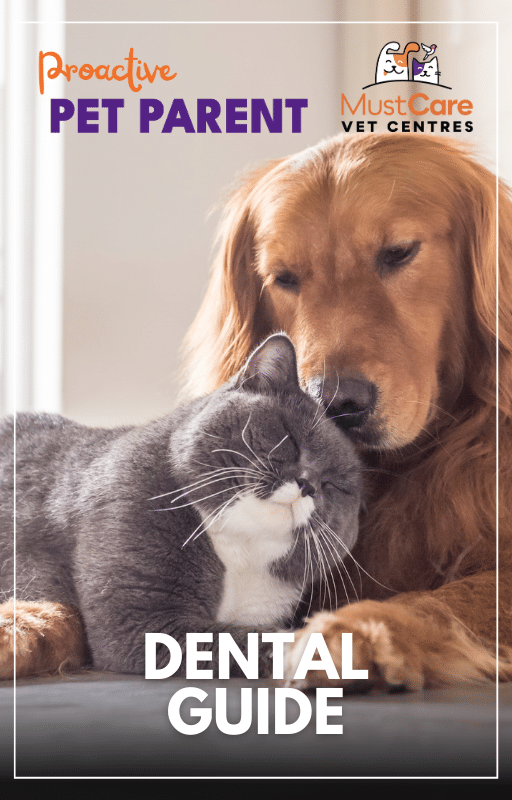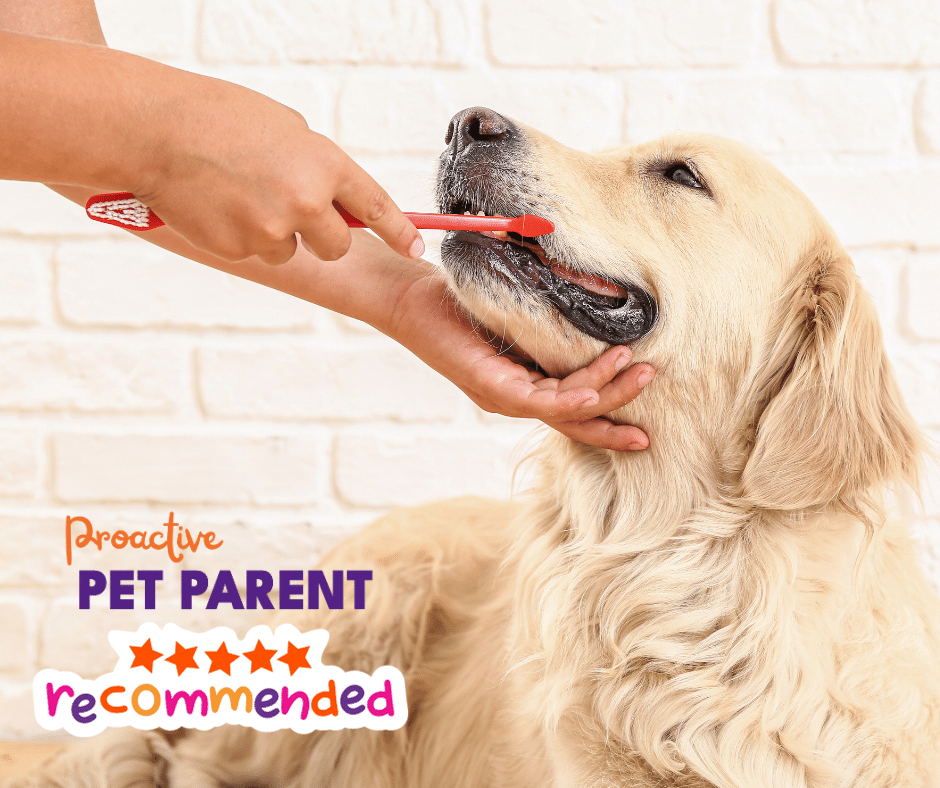Share This Blog With Other Pet Parents!
A Guide to Brushing Your Pet’s Teeth
In this comprehensive blog, we delve deep into the essential practice of brushing your pet’s teeth, a key component of overall pet health and wellness. Whether you’re a seasoned pet owner or new to the world of furry companions, this guide is designed to equip you with all the knowledge and techniques you need for maintaining optimal dental hygiene in your dogs and cats.
We cover everything from selecting the right toothbrush and toothpaste for your pet to mastering the technique of brushing those hard-to-reach teeth. Our goal is to make this routine as stress-free and effective as possible for both you and your pet.
What you’ll learn from this blog:
- Why dental care is crucial for pets
- Basic dental anatomy of dogs
- Basic dental anatomy of cats
- How anatomy affects brushing techniques
- How to acclimatise your pet for having their mouth handled
- Creating a positive environment
- Step-by-step – how to brush your dogs teeth
- Step-by-step – how to brush your cats teeth
- Challenges and solutions

For all you need to know, download our
FREE Dental Guide
This blog is part of our Proactive Pet Parent series! This is just the beginning… To see more blogs, click here! Better yet, sign-up to our newsletter to receive these directly to your inbox each month.
Sign-up To The Proactive Pet Parent Newsletter
Why dental care is crucial for pets
Understanding the importance of dental care in pets is essential for any responsible pet owner. Just like in humans, poor dental hygiene in dogs and cats can lead to a host of health problems, some of which can significantly impact their overall well-being and quality of life.
- Tooth Decay and Loss: Pets can suffer from tooth decay and loss without regular dental care, leading to pain and difficulty eating.
- Gum Disease: Plaque and tartar buildup can cause periodontal disease, resulting in swollen, bleeding gums, and potentially damaging the jawbone and connective tissue.
- Systemic Infections: Bacteria from dental diseases can enter the bloodstream, affecting major organs like the heart, liver, and kidneys.
- Bad Breath: Chronic bad breath in pets can be a sign of underlying dental problems.
- Impact on Organ Function: Dental health issues can exacerbate existing health conditions, especially in older pets.
- Behavioural Changes: Dental pain can lead to changes in behaviour, such as increased irritability or decreased interest in food.
- Nutritional Consequences: Dental problems can affect eating habits and lead to nutritional deficiencies.
- Quality of Life: Chronic dental pain can significantly diminish a pet’s quality of life, causing a gradual decline in general health and happiness.
Basic Dental Anatomy of Dogs
- Number of Teeth: Adult dogs typically have 42 teeth, including incisors, canines, premolars, and molars.
- Tooth Structure: Dog teeth are designed for tearing and grinding, with sharp canines for gripping and large molars for crushing.
- Growth Timeline: Puppies start with 28 deciduous (baby) teeth, which are replaced by adult teeth around six months of age.
Basic Dental Anatomy of Cats
- Number of Teeth: Adult cats usually have 30 teeth, fewer than dogs.
- Tooth Structure: Cat teeth are sharp and pointed, ideal for cutting and shearing. Unlike dogs, cats have very few flat molars since their diet in nature requires less grinding.
- Growth Timeline: Kittens are born toothless, develop 26 deciduous teeth, and these are replaced by their permanent teeth by six months.
How This Affects Brushing Techniques
- Brushing Angle and Motion: Due to the pointed nature of cat teeth, brushing should be more delicate, focusing on the gum line. For dogs, a more robust brushing motion is needed, especially on the larger back molars.
- Frequency of Brushing: Dogs may benefit from daily brushing due to the presence of larger molars and a greater number of teeth, which can trap more food and debris. Cats, with their sharper and fewer teeth, might require less frequent but still regular brushing.
- Size of Brush and Type of Toothpaste: Smaller brushes or finger brushes are often better for cats due to their smaller mouths. Dogs can usually accommodate larger toothbrushes. The choice of toothpaste should be pet-specific, as human toothpaste can be harmful to both dogs and cats.
Acclimatising Your Pet to Having Their Mouth Handled
- Start Early: If possible, begin handling your pet’s mouth when they are young. This can help them become more comfortable with the process as they grow.
- Gradual Introduction: Begin by gently touching around your pet’s mouth and lips with your finger. Reward them with treats and praise to associate this handling with positive experiences.
- Mouth Inspection: Once your pet is comfortable with external touching, carefully lift their lips and lightly touch their teeth and gums. Again, use treats and positive reinforcement.
- Mock Brushing: Before introducing a toothbrush, simulate the brushing motion with your finger or a soft cloth. This helps your pet get used to the sensation of something moving inside their mouth.
Creating a Positive Environment for Dental Care
- Choose a Calm Time: Select a time when your pet is relaxed and calm, such as after a meal or playtime.
- Comfortable Setting: Ensure the environment is quiet and comfortable. Avoid loud noises or distractions that could stress your pet.
- Positive Reinforcement: Use plenty of praise and treats during and after the brushing session. This helps your pet associate teeth brushing with positive outcomes.
- Be Patient and Consistent: Patience is key. If your pet resists, don’t force them. Try again later, and maintain consistency in your approach.
By taking these steps, you can help your pet become more comfortable with the process of teeth brushing, making it a more enjoyable experience for both of you. Remember, the goal is to make dental care a regular and stress-free part of your pet’s routine.
Step-by-step – how to brush your dogs teeth
- Choose the Right Time: Brush your dog’s teeth when they are calm, perhaps after a walk or play session.
- Introduce the Toothbrush and Toothpaste: Let your dog sniff and taste pet-safe toothpaste from the brush to get used to it.
- Start Slowly: Gently open your dog’s mouth and touch the brush to a few teeth at the front. Gradually increase the number of teeth you brush each time.
- Brush in Circles: Use a circular motion to brush each tooth, focusing on the area where the tooth meets the gum line.
- Don’t Forget the Back Teeth: The back teeth can harbour more plaque, so ensure you reach these without forcing your dog’s mouth open too wide.
- Reward Your Dog: Always end with a treat or their favorite game to make the experience positive.
Step-by-step – how to brush your cats teeth
- Create a Comfortable Environment: Brush your cat’s teeth in a quiet, familiar place.
- Introduce the Brush and Toothpaste Gradually: Let your cat smell and taste the toothpaste. Use a smaller brush or finger brush designed for cats.
- Lift the Lips Gently: Expose your cat’s teeth by softly lifting their lips.
- Use Gentle Strokes: Brush with gentle strokes, focusing on the canines and back teeth, as these are most prone to tartar.
- Be Quick and Efficient: Cats have less patience for brushing, so aim to be quick but thorough.
- Positive Reinforcement: Always associate teeth brushing with a positive experience, like a favorite treat or cuddle.
Challenges and solutions
- Resistance: If your pet resists, don’t force it. Try again later, gradually increasing their exposure to the process.
- Gagging or Discomfort: If your pet gags or seems uncomfortable, you might be brushing too hard or reaching too far back. Be gentle and work within their comfort zone.
- Anxiety: For anxious pets, try using dental wipes initially or wrap a piece of gauze around your finger with a bit of toothpaste.
- Consistency is Key: Regular brushing, even if it’s just a few teeth at a time, can help your pet get used to the process.
Remember, patience and consistency are vital. It’s not uncommon for pets to take several weeks to get used to teeth brushing. The goal is to make it a stress-free experience, ensuring your pet’s dental health is well maintained.

